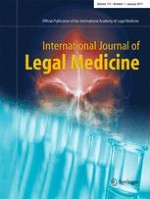Erschienen in:

18.10.2016 | Original Article
Immunohistochemical detection of intrathrombotic fibrocytes and its application to thrombus age estimation in murine deep vein thrombosis model
verfasst von:
Mizuho Nosaka, Yuko Ishida, Akihiko Kimura, Takashi Kawaguchi, Hiroki Yamamoto, Yumi Kuninaka, Toshikazu Kondo
Erschienen in:
International Journal of Legal Medicine
|
Ausgabe 1/2017
Einloggen, um Zugang zu erhalten
Abstract
Deep vein thrombi are dissolved after fibrosis process along with an increase of thrombus age. Fibrocytes are circulating bone marrow-derived cells with mesenchymal features that potentially have a unique and critical function in fibrosis. In this study, a double-color immunofluorescence analysis was carried out by using anti-CD45 and anti-collagen type I antibodies to examine the time-dependent appearance of fibrocytes in the murine model of stasis-induced deep vein thrombosis. The thrombus ages were 1, 3, 5, 7, 10, 14, and 21 days. In a thrombus age of less than 5 days, CD45+ and collagen type I+ fibrocytes were never detected. The intrathrombotic fibrocytes were initially observed in thrombi aged 7 days, and their number increased with advances in thrombus age. In a quantitative morphometrical analysis, the average number of intrathrombotic fibrocytes was highest in 14-day-old thrombi, and all of the five samples aged 14 days had the fibrocyte number of more than 25, and in three out of them, the number of intrathrombotic fibrocytes was over 30. On the contrary, in all of thrombus samples with the postligation intervals of 10 and 21 days, the number of intrathrombotic fibrocytes was less than 25. These observations imply that thrombi containing fibrocytes are at least 7 days old and that a fibrocyte number exceeding 30 would indicate the thrombus age of approximately 14 days. Our observations indicate that the detection of fibrocytes could be useful for thrombus age determination.











